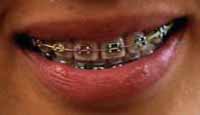Orthodontics/ Braces for Children

What is orthodontics?
Orthodontics is the dental specialty that focuses on the development, prevention, and correction of irregularities of the teeth, bite, and jaws. Orthodontists also have specialized training in facial abnormalities and disorders of the jaw. Your dentist may refer your child to an orthodontist. The American Dental Association recommends that every child have an orthodontic evaluation by 7 years of age.
Why choose orthodontic treatment?
Any orthodontic problem may be classified as a malocclusion, or "bad bite." The following problems may be helped or minimized with proper orthodontic treatment:
-
Misaligned, crooked, or crowded teeth
-
Missing teeth
-
Extra teeth
-
An overbite
-
An underbite
-
An openbite
-
Misaligned or incorrect jaw position
-
A disorder of the jaw joint
What age should my child get braces?
In most cases, the ideal age for braces and other orthodontic treatments is between 10 and 14 years of age. Moving and correcting the alignment of the teeth follows the same process regardless of age. However, an adult mouth must overcome already-positioned facial bones and jaw structure. Thus, overcoming most types of malocclusions may require more than one type of orthodontic treatment for adults and can sometimes involve jaw surgery.
What are the different types of braces available?
Braces generally come in three varieties:
-
Brackets, metal or plastic, clear or tooth-colored, that are bonded to teeth
-
Lingual-type brackets that attach to the back of teeth, hidden from view
-
Bands that cover most of the teeth with metal bands that wrap around the teeth.
-
Invisible, clear aligners that can be removed from the mouth
The first three types use wires to move the teeth to the desired position. Clear, removable aligners do not use wires and may also be an option. Aligners are custom-formed plastic guides that fit over the teeth and are used in a series to move the teeth into their desired positions. Ask your orthodontist if they are right for you.
Oral healthcare and braces
The following recommendations will help eliminate, or reduce, any oral health problems while your child's teeth are in braces:
-
Make certain that your child is brushing his or her teeth carefully after every meal with fluoride toothpaste and a soft-bristled toothbrush, as food becomes easily lodged in the braces. A new toothbrush may be needed every 3 to 4 months, or sooner if bristles are broken or frayed. A worn toothbrush doesn't do a good job of cleaning the teeth.
-
Make certain that your child is flossing daily between the teeth and the braces. A floss threader may be useful to carry the floss under the arch wire.
-
A proxabrush may be a good tool to remove food or debris from between the teeth.
-
A dental water jet or oral irrigator can be used to remove food and debris from between the teeth, brackets, and wires.
-
Be sure your child has his or her teeth cleaned every 6 months, or as often as recommended by your dentist.
-
Limit your child's sugar and starch intake, as debris left behind from these types of foods may turn into damaging acids. These promote tooth decay and cause white spots around the braces.
-
Avoid hard or sticky snacks that may be hard to remove from the orthodontic equipment in your child's mouth. This includes hard foods, such as popcorn, pretzels, hard candy, nuts, and sticky foods, like chewing gum, caramel, and other chewy candy. Avoid chewing ice.
Ask your dentist about prescription fluoride toothpaste or the application of a fluoride varnish around the braces to minimize white spots on the teeth after the braces come off.



